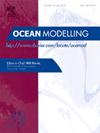在温带、微潮和受限制的地中海沿岸泻湖中的波浪
IF 2.9
3区 地球科学
Q2 METEOROLOGY & ATMOSPHERIC SCIENCES
引用次数: 0
摘要
由于生态危机和了解其生态的物理驱动因素,特别是沉积物运输和营养再悬浮的需要,这项研究的重点是地中海西南部一个高盐沿海泻湖Mar Menor的波浪动力学。该研究采用SWAN模型对泻湖气象站记录的风进行波浪模拟,涵盖2019年8月至10月的数据。模型结果与部署在气象站附近的ADCP的数据进行了验证。结果表明,马诺岛的风力强度较低,偶有强烈的东北风,浪高最高可达1.25米。自组织图(SOMs)分析提供了波高、周期、波长和底轨道速度的分类,从而产生六种波图类别。分析显示,最大的波浪与南风有关,沉积物再悬浮在风暴期间最为显著,不会影响泻湖中心最深的6米深的部分。该研究的结论是,波浪引起的轨道速度可以在极端事件中调动沉积物的再悬浮,潜在地扰乱缺氧的底部。2019年9月12日至15日发生山洪暴发后,泻湖形成了强烈的分层,底层缺氧。虽然不强烈,但长时间的风驱动的波浪有助于打破分层,造成一个月后在泻湖北部观察到的鱼类大量死亡。识别与每个SOM地图类别相关的特定风型,显示了SOM从风数据预测波浪型的预测潜力。由于SOMs的计算需求低且仅依赖于风力预报,因此它为早期预警系统和管理环境敏感地区(如沿海泻湖)的生态风险提供了实用工具。本文章由计算机程序翻译,如有差异,请以英文原文为准。
Waves in a temperate, microtidal and restricted Mediterranean coastal lagoon
The study focused on wave dynamics in the Mar Menor, a hypersaline coastal lagoon in the Southwestern Mediterranean Sea, prompted by ecological crises and the need to understand the physical drivers of its ecology, especially sediment transport and nutrient resuspension. The research employs the SWAN model for wave simulations forced with recorded winds from a meteorological station in the lagoon, covering data from August to October 2019. Model results were validated against data from an ADCP deployed near the met station. The results indicated that Mar Menor experiences low-intensity winds, with occasional strong Northeasterly winds causing the highest waves of up to 1.25 meters high. Self-Organizing Maps (SOMs) analysis provides a classification of wave height, period, wavelength, and bottom orbital velocity, resulting in six wave map categories. The analysis revealed that the largest waves are linked to Southerly winds, and sediment resuspension is most significant during storms, not affecting the deepest 6-meter depth central part of the lagoon. The study concludes that wave-induced orbital velocities can mobilize sediment resuspension during extreme events, potentially disturbing the anoxic bottom. The lagoon was strongly stratified after a flash flood occurred between 12–15 September 2019 with an anoxic bottom layer. Waves driven by winds blowing for long time, although not strongly, contributed to break the stratification producing the fish mass mortality observed in the northern part of the lagoon one month later. Identifying specific wind patterns associated with each SOM map category shows the predictive potential of SOMs for forecasting wave patterns from wind data. Due to their low computational requirements and reliance solely on wind forecasts, SOMs analysis offer a practical tool for early warning systems and for managing ecological risks in environmentally sensitive areas such as coastal lagoons.
求助全文
通过发布文献求助,成功后即可免费获取论文全文。
去求助
来源期刊

Ocean Modelling
地学-海洋学
CiteScore
5.50
自引率
9.40%
发文量
86
审稿时长
19.6 weeks
期刊介绍:
The main objective of Ocean Modelling is to provide rapid communication between those interested in ocean modelling, whether through direct observation, or through analytical, numerical or laboratory models, and including interactions between physical and biogeochemical or biological phenomena. Because of the intimate links between ocean and atmosphere, involvement of scientists interested in influences of either medium on the other is welcome. The journal has a wide scope and includes ocean-atmosphere interaction in various forms as well as pure ocean results. In addition to primary peer-reviewed papers, the journal provides review papers, preliminary communications, and discussions.
 求助内容:
求助内容: 应助结果提醒方式:
应助结果提醒方式:


